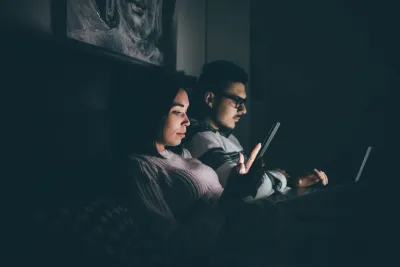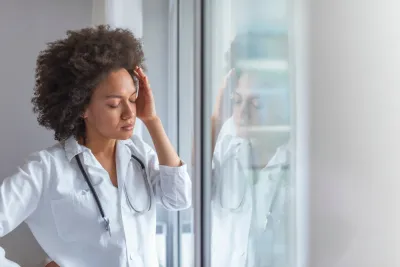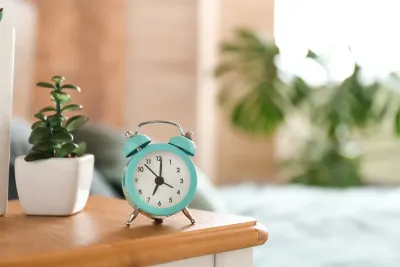Blue Light and Its Impact on Sleep: What You Need to Know
Sleepme Editorial Team • May 09, 2025

Key Takeaways
- Device Exposure: Screens, TVs, phones, and tablets emit high levels of blue light, especially damaging before bedtime.
- Sleep Disruptor: Blue light affects with melatonin production, making it harder for your body to wind down at night.
- Night Shift Mode: Tools like filters, dimmable lamps, and nighttime screen settings can help protect your sleep.
- Evening Strategy: Ditch the screens an hour before bed to give your brain the "time to sleep" signal it needs.
- Cooler Sleep Tip: Pairing blue light reduction with temperature regulation, such as a bed cooling system, can supercharge your sleep quality.
We all spend a lot of time in front of screens, including using devices, whether watching TV in the evening or using our cell phones leading up to bedtime. These screens emit a large amount of blue light, which can affect your sleep.
Blocking nocturnal blue light is crucial for maintaining healthy sleep patterns, as it affects circadian rhythms and melatonin production, which are essential for a good night's sleep and can help mitigate the negative effects of blue light.
Before we jump into the effects, ask yourself the following question:
Do you use your smartphone, tablet, or computer at bedtime?
If you said yes, you are among the 70% of adults who use an electronic device in their bedroom or bed. [1] Additionally, that study found that 75% of children used some electronic device before bedtime. [2]
Unfortunately, these devices interrupt our natural sleep cycles. Decreasing the amount of exposure to blue light leading up to bedtime is a vital way to get your body naturally ready for sleep
Sleep Statistics: One out of five say they send or receive work-related emails before bed.
Let’s find out how this works and how to limit exposure to improve your sleep.
Unlock Better Sleep with Bed Cooling Systems
Revamp your sleep experience with the Chilipad bed cooling sleep system and discover the benefits of personalized temperature control for a refreshed and rejuvenated morning.
What is Blue Light?
Blue light is a part of the visible light spectrum. It can affect our sleep cycles, alertness, and hormone production.
The most familiar sources are found in our televisions, tablets, computers, computer monitors, and smartphones. These devices use light-emitting diode (LED) technology, which gives off blue light and contributes to our daily exposure to it.
These newfound sources in our daily lives are causing us to be overwhelmed by a sea of blue and have arguably tipped the balance of our exposure to genuine concern.
Almost all visible light passes through the cornea and lens to reach the retina, raising concerns about the potential long-term effects of exposure to blue light from screens. While it’s not inherently unhealthy, it has various medical benefits. Overexposure has been argued to disrupt our circadian rhythms and lead to decreased overall mental health.
Sources of Blue Light Exposure
We get it from various places, both natural and from things we make. But we get a lot from our gadgets like phones, tablets, and TVs, especially at night. Even the lights in our homes and offices, like LED and fluorescent bulbs, give off some. All this light can really mess with our sleep and how we feel.
Effects of Blue Light
The effects on our mental health are still being researched, but it is well-established that exposure to blue light affects our natural sleep patterns. It affects the production of melatonin, the hormone that regulates our sleep patterns, also known as our circadian rhythm.
When we are exposed to blue light before bedtime, it can suppress melatonin production, making it harder to fall asleep and reducing the quality of our sleep.
Read More: What is Deep Sleep and Why It's Important
Additionally, the exposure has been linked to digital eye fatigue, which can cause headaches, blurred vision, and dry eyes. Prolonged exposure has also been linked to an increased risk of macular degeneration and cataracts, highlighting the importance of managing screen time and blue light exposure.
Deep Sleep Study: Effects of pre-bedtime blue-light exposure on ratio of deep sleep in healthy young men.

Does Blue Light Affect Sleep?
Short answer: yes. But it isn’t that bad. Understanding the effects on sleep is crucial for optimizing good sleep quality. It can keep you awake as it reduces the body’s release of melatonin, a hormone that makes us feel exhausted. While this may be helpful during the earlier parts of the day, it becomes unhelpful at night when we’re ready for sleep.
Vulnerability to nocturnal blue light misleads your mind into thinking it’s still daylight hours, causing you to be more alert and making it harder to fall asleep and get a good rest at night. This disruption in circadian rhythms can ultimately affect cognitive functions and overall health. Additionally, exposure can lead to sleep disorders and cognitive dysfunction.
This type of colored light, even from artificial light sources like your chosen digital devices, is not inherently bad. The light these devices emit can help promote proper melatonin production, improve mood, increase alertness, and support a healthy weight and adrenal function.
Overexposure can lead to health problems. The clear insight is how it affects our eyes while looking at blue light. But it also dramatically affects us while our eyes are closed and we’re trying to sleep. It has also been linked to blurred vision, cataracts, dry eyes, eye fatigue, and digital eyestrain.
Blue Light and Circadian Rhythm
It plays a significant role in regulating our circadian rhythm. Exposure to natural blue light during the day helps to regulate our circadian rhythm, while exposure to artificial lights, including blue light at night, can disrupt it. The suprachiasmatic nucleus (SCN), the part of the brain that controls our circadian rhythm, is sensitive to blue light.
When we are exposed, it signals the SCN, which helps regulate our internal clock. However, exposure to these devices at night can confuse the SCN, making it harder to fall asleep and reducing the quality of our sleep. Understanding this relationship can help us make better choices about our exposure to light throughout the day.
Affects Your Eyes Sleep
This light can significantly affect our eyes, sleep, and overall health. Prolonged exposure can cause digital eye fatigue, leading to headaches, blurred vision, and dry eyes. Additionally, exposure to blue light before bedtime can disrupt our sleep patterns, making it harder to fall asleep and reducing the quality of our sleep.
This disruption can lead to a range of health problems, including fatigue, decreased productivity, and an increased risk of chronic diseases such as diabetes and heart disease. To mitigate these effects, it is essential to take steps to reduce your exposure to it, such as using blue light-filtering glasses or apps and avoiding screens for at least an hour before bedtime.
By understanding the effects of this colored light on our health, we can take proactive steps to reduce our exposure and promote healthy sleep habits, ultimately improving our overall quality of life.
The Risks of More Blue Light
Exposure to more blue light has been linked to several risks. One of the most immediate effects is heavinesseyes, characterized by eye fatigue, dryness, irritation, headaches, and blurred vision. Symptoms of digital eye strain include headaches, blurred vision, and pain in the neck and shoulders. Prolonged exposure, especially from digital devices, can exacerbate these symptoms.
Staring at screens in the evening can really mess with your body’s natural sleep-wake cycle. This is because this light tricks your brain into thinking it’s still daytime, which stops your body from making melatonin, the hormone that helps you feel sleepy.
This can make it hard to fall asleep, leaving you tired even if you slept all night. And if you’re constantly exposed, it might even increase your risk of eye problems like macular degeneration, which can damage your vision.
Devices that Emit Blue Light
You may not be aware that many everyday devices gives off blue light. These devices include smartphones, tablets, laptops, desktop computers, LED and fluorescent light bulbs, and televisions.
A recent study found that people spend roughly seven hours a day on electronic devices. [3] Now, that’s a lot of time staring at blue light. Limiting digital overload and cutting down on blue light before bed is key to better sleep. Struggling to put the phone or tablet down at night? You're not alone—and there's help for that.
Yellow-tinted lenses can help mitigate blue light exposure from these devices by increasing contrast and easing digital eye strain. Some companies understand the effects of it and now offer settings that allow you to reduce the amount of blue light emitted, such as the Night Shift feature on iPhones and iPads or the Blue Light Filter on Android devices.
Below are standard devices that project blue light.
- Smartphones
- Tablets
- Laptops
- Desktop Computers
- LED and Fluorescent Light Bulbs
- Television
- Gaming Devices
- E-readers
- Digital Clocks
- Smart Watches
How You Can Reduce Blue Light Exposure
The most effective strategy to reduce exposure is simply turning off the devices one hour before bedtime. Additionally, you can block this blue colored light to protect your eyes from digital strain caused by devices like smartphones and computers. Blue light glasses help in reducing digital eye fatigue, although research on their effectiveness is still inconclusive.
Using screen filters, computer glasses with yellow-tinted lenses, and anti-reflective lenses can specifically limit the exposure to blue light and its potential effects on eye health. Any of the below combinations of these tips will help you find your sleep switch and start sleeping great immediately.
Blue Light Filters
Tech companies know all about how harmful it can be on health and are doing their part to stay ahead of the curve and ensure you augment how you spend your time on their devices, not the amount of time. Filters are effective in blocking the light, which helps protect your eyes from potential damage.
If you can’t limit the time you spend on your device, limit the amount of blue light your device emits.
Blue Light Glasses
Wearing blue light-blocking glasses can help. The lenses can ease tired eyes by increasing contrast. These glasses can also help with heavy eyes caused by overexposure to digital devices.
iPhone and PC’s
There are functions on most Apple products, PCs, and Smartphones that enable you to filter the amount of blue light you are exposed to. It is called Night Shift on Apple products and Night Light on PCs. Both filters are amazing augmentations if you have to use your technology at night.
Note: Even dim light can interfere with a person's circadian rhythm and melatonin secretion.
Cut Back on Screen Time
Setting a schedule is important. This isn't always the easiest in the age of information, but sometimes we need to schedule time apart. Just as we set parameters in any other arena of our lives to maximize efficiency, so should we set a schedule on the amount of time we spend on our electronic devices.
Set an alarm that reminds you to turn off your devices. This can be done 2-3 hours before going to bed.
Helpful Tip: Set an alarm 1 hour before bed to remind you to stop using your devices.
Digital Device Detox
Just say no. Many have suggested that your bedroom should be a space free of digital interaction. Instead of interacting with your device, let your device interact with you. By taking advantage of the latest sleep-tracking apps and devices, you can benefit from healthy technology while maintaining your natural circadian rhythms.
The light emitted from tablets and gaming systems can significantly affect sleep quality and overall health.
Replace your bedroom lamps with bright light bulbs that emit warmer, orange or red lights, or turn the lights off altogether and enjoy an old-fashioned evening by candlelight. This will help you relax and get a great night’s sleep!

Final Thoughts
Now we fully understand how the light emitted by electronic devices, LED and fluorescent light bulbs, and even some natural sources can negatively impact your sleep.
Exposure at night can suppress the production of melatonin, the hormone that regulates sleep, and disrupt your body's natural sleep-wake cycle.
However, using some helpful steps above can reduce exposure before bedtime to improve sleep quality. It's time to take charge, prioritize your health, and understand the impact of blue light on sleep. You can now try some tips and see what works best for you.
Frequently asked questions
Do TVs Have Blue Light?
Yes, TVs emit blue light, which can disrupt melatonin production and make it harder to fall asleep. To reduce the impact, limit screen time before bed or use blue light–reducing settings or glasses.
How Can I Reduce Blue Light Exposure Before Bedtime?
To minimize blue light exposure in the evening and promote better sleep:?
- Limit screen time at least one hour before bedtime.
- Use blue light filtering settings or apps on electronic devices.
- Consider wearing blue light blocking glasses in the evening.
- Opt for dim, warm-colored lighting in the evening instead of bright, cool-toned lights.
- Establish a relaxing pre-sleep routine that doesn't involve electronic devices.?
Is Blue Light Exposure Always Harmful?
Not necessarily. Blue light exposure during daytime hours can be beneficial by boosting alertness, mood, and cognitive function. The concern arises with excessive exposure during the evening and night, which can interfere with the body's natural sleep-wake cycle.
Therefore, while blue light has its advantages, it's important to manage exposure appropriately to maintain healthy sleep patterns.?
Which Devices Commonly Emit Blue Light?
Common devices that give off blue light include:?
- Smartphones
- Tablets
- Computers and laptops
- Televisions
- LED and fluorescent lighting?
These devices use LED technology, which emits significant amounts of blue light, contributing to increased exposure, particularly during nighttime.?
Citations/Resources
[1] Bhat, S., Pinto-Zipp, G., Upadhyay, H., & Polos, P. G. (2018). “To sleep, perchance to tweet”: in-bed electronic social media use and its associations with insomnia, daytime sleepiness, mood, and sleep duration in young adults. Sleep Health, 4(2), 166–173. View Study
[2] LeBourgeois, M. K., Hale, L., Chang, A. M., Akacem, L. D., Montgomery-Downs, H. E., & Buxton, O. M. (2017). Digital Media and Sleep in Childhood and Adolescence. Pediatrics, 140(Suppl 2), S92–S96. View Study
[3] Howarth, J. (2022, September 21). Alarming Statistics (2022). Exploding Topics. View Resource









